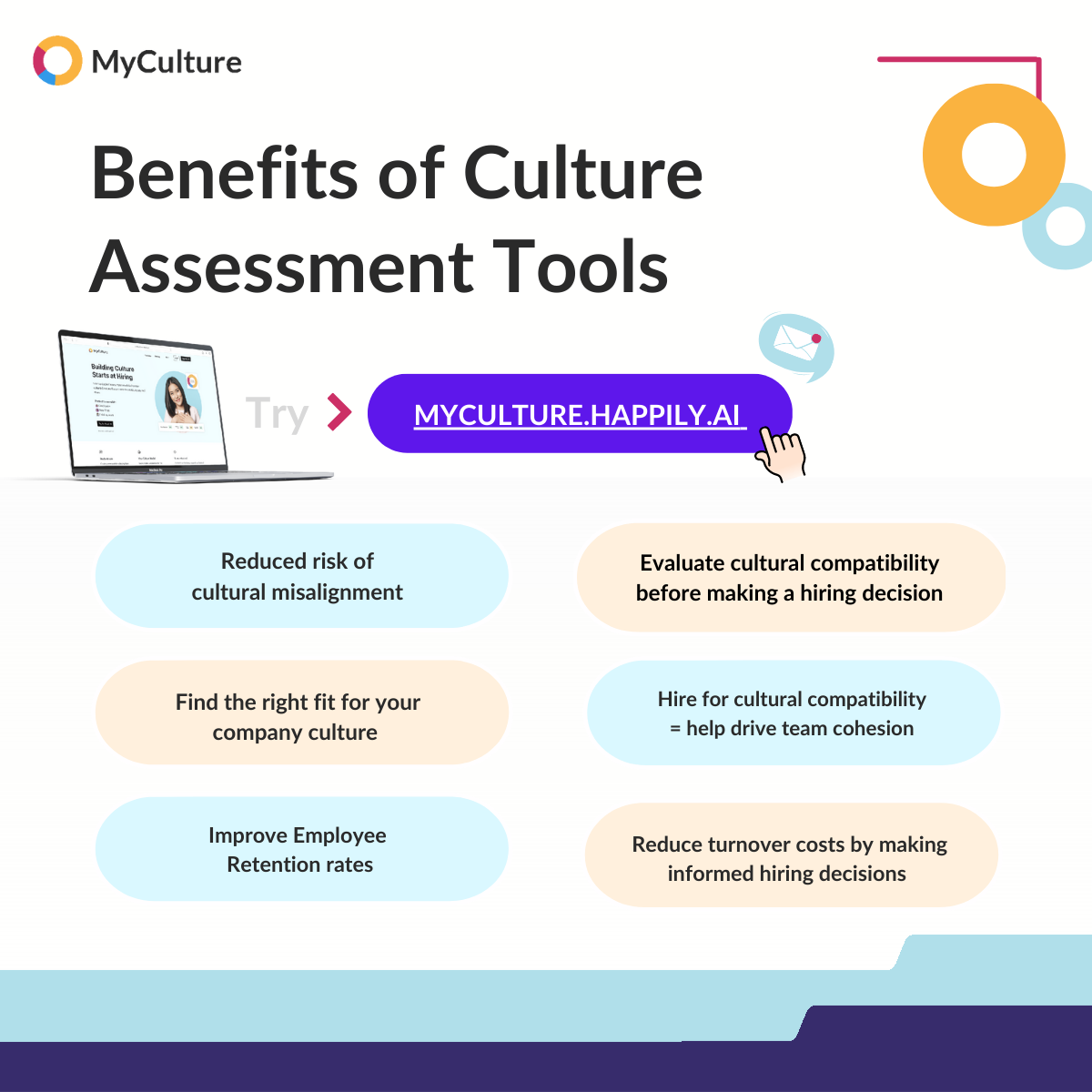Culture Assessment tools: A Guide
Culture is a critical component of any organization, as it shapes the behavior, values, and beliefs of its members. A company's culture is shaped by its leadership, business strategies, and the overall working environment. It impacts employee morale, productivity, and even the bottom line. Therefore, it is important for organizations to periodically assess their company culture to ensure it aligns with their business goals and values. (Here are our three tips to improve company culture!) A positive organizational culture can enhance performance, improve communication, and foster a sense of belonging and commitment among employees. However, a negative or dysfunctional culture can have the opposite effect, leading to low morale, poor performance, and high turnover.
Conducting a culture assessment can provide valuable insights into the current state of an organization's culture and help identify areas that may need improvement. This guide will provide an overview of culture assessment tools, including their purpose, how they are used, why organizations use them, who it is for and how to perform a cultural assessment. Whether you are a business leader, HR professional, or consultant, this guide will provide the information you need to understand and effectively use culture assessment tools to improve your organization's culture. The article is structured as the following:
1. What is a culture assessment tool?
2. What is the purpose of a culture assessment tool?
3. Why do organizations use culture assessment tools?
4. Who are culture assessment tools for?
5. How to perform a Cultural Assessment?
6. What are the benefits of using a Culture Assessment tool?
What is a Culture Assessment tool?
A culture assessment tool is a tool that helps organizations evaluate and measure the current state of their company culture. Today’s culture assessment tools are extensive and typically involve data collection methods such as daily pulse surveys, interviews, or focus groups, which are used to gather information about the values, beliefs, and behaviors that are prevalent within the organization. The goal of using culture assessment tools is to provide a comprehensive understanding of an organization's culture and to identify areas of strength and weakness. Some common elements that are often measured in a culture assessment include leadership styles, communication, teamwork, decision-making processes, and values alignment.
This type of tool is typically used by HR departments to help identify areas where the company's culture is strong and areas where it may need to be improved.
What is the purpose of a Culture Assessment tool?
The purpose of a culture assessment tool is to evaluate the current state of a company's culture, such as:
a) To assess potential candidates before hiring them to measure the level of culture fit in terms of values and beliefs, and
b) To assess new hires to ensure they are familiar with the working style and environment of the company.
By conducting a culture assessment, HR departments can gain a better understanding of the underlying beliefs, values, and practices that are shaping the company's culture, and they can use this information to make more informed decisions about how to develop and improve the culture moving forward. This can ultimately help to create a more positive, productive, and engaging work environment for employees. By regularly conducting culture assessments, organizations can ensure that their culture is supportive of their business objectives and that it is conducive to employee engagement, productivity, and overall success.
Why do organizations use a Culture Assessment Tool?
There are multiple reasons why organizations might choose to use a culture assessment tool. For example, they may be looking to improve morale and engagement among their employees, or they may want to identify and address any issues or challenges that are affecting their culture. Additionally, organizations may use a culture assessment tool as part of a broader effort to align their culture with their business strategy and goals. By understanding their culture and making improvements where needed, organizations can better position themselves for success and achieve their business objectives. Here are some examples:
- To identify areas for improvement: Culture assessments can help organizations identify areas where their culture may be hindering rather than supporting their business goals. For example, if employees report low levels of trust or communication, this could indicate a culture that is not conducive to collaboration and innovation.
- To track progress: By regularly conducting culture assessments, organizations can track changes in their culture over time and measure the impact of culture-related initiatives and interventions.
- To align culture with business goals: A culture assessment can help organizations ensure that their culture aligns with their business goals and values. This can help create a culture that supports and enhances business performance.
- To engage employees: Culture assessments can provide a platform for employees to voice their opinions and experiences, which can foster a sense of ownership and engagement within the organization.
- To attract and retain talent: A positive company culture can be a major factor in attracting and retaining top talent. By regularly assessing and improving their culture, organizations can create an attractive work environment that helps them compete for top talent.
Who are Culture Assessment tools for?
Culture assessment tools can be used by a wide range of stakeholders, including:
- Senior leadership: Culture assessments can help leaders understand the impact of their leadership style and decision-making processes on the culture of the organization.
- Human resources professionals: HR professionals can use culture assessments to identify and address issues related to employee engagement, retention, and performance.
Culture assessment tools may also be used by employees themselves. For example, an organization might ask employees to complete a culture assessment survey as part of an effort to gather feedback and insights from the people who are directly experiencing the company's culture. By involving employees in the culture assessment process, organizations can gain a more comprehensive and nuanced understanding of their culture and the factors that are influencing it. This can help to ensure that any efforts to improve the culture are based on the perspectives and experiences of the people who are most affected by it.
How to perform a Cultural Assessment?
There are several steps that organizations can follow to perform a cultural assessment. Here is a brief overview of the process:
- Define your organizational values and traits: Before starting the assessment, it is important to define the goals and objectives that the organization hopes to achieve. This will help to guide the assessment process and ensure that it is focused and relevant.
- Identify the key dimensions of culture that will be assessed: There are many different aspects of culture that can be assessed, such as leadership, collaboration, innovation, and communication. It is important to identify the key dimensions that are most relevant to the organization and focus the assessment on these areas.
- Select the appropriate assessment tools and method:; There are many different culture assessment tools, such as MyCulture, that helps organizations with assessing culture fit in as quick as 15 minutes (Try here). It is important to choose the tools and methods that are best suited to the organization's goals and the dimensions of culture that are being assessed.
- Gather and analyze data: Once the assessment tools and methods have been selected, it is time to collect data from employees and other stakeholders. This involves administering surveys, conducting interviews of employees, new hires or potential candidates. The collected data should then be carefully analyzed to identify patterns, trends, and areas for improvement.
- Monitor and evaluate the effectiveness of the plan: After the plan has been implemented, it is important to monitor and evaluate its effectiveness. By monitoring and evaluating the effectiveness of the plan, organizations can ensure that they are making progress toward their goals and that their efforts in creating a high-performing culture can be implemented.
Alternatively, view our walkthrough on How to perform a Culture Assessment with MyCulture here.
What are the benefits of using a Culture Assessment tool like MyCulture?
A culture assessment tool (like MyCulture) has been used by a number of organizations looking to improve team productivity and cohesion, reduce turnover costs, and make more informed hiring decisions. The following are some benefits of using a culture assessment tool:
One of the primary benefits of MyCulture is its ability to increase team productivity and cohesion. By providing a detailed assessment of an individual's cultural fit within an organization, MyCulture helps to ensure that new hires are aligned with the company's values and goals. This can lead to more efficient and effective collaboration, as team members are able to understand and respect one another's differences, and work together more seamlessly.
Another benefit of MyCulture is its ability to reduce turnover costs. By identifying potential mismatches between an individual's cultural values and those of the organization, MyCulture can help to prevent costly turnover due to cultural misunderstandings or misalignment. By ensuring that new hires are a good fit with the company's culture, organizations can reduce the risk of employee turnover and the associated costs.
In addition to its benefits in terms of team productivity and cohesion, MyCulture can also be used to evaluate cultural compatibility before making a hiring decision. By using MyCulture to assess the cultural fit of potential candidates, organizations can ensure that they are making informed hiring decisions that are in line with their company culture. This can help to reduce the risk of hiring mistakes, and ensure that new hires are able to thrive within the organization.
Finally, MyCulture's proven methodology ensures that new hires are a good fit with the company culture. By using a comprehensive approach to assessing cultural fit, MyCulture helps to ensure that new hires are able to contribute to the organization in a meaningful way, and are able to thrive in the company's unique environment.

Overall, using a culture assessment tool like MyCulture has proven to be an effective tool for improving team productivity and cohesion, reducing turnover costs, and making informed hiring decisions. Its comprehensive approach to assessing cultural fit has helped a number of organizations to build strong and successful teams, and to create a positive and supportive work environment.









